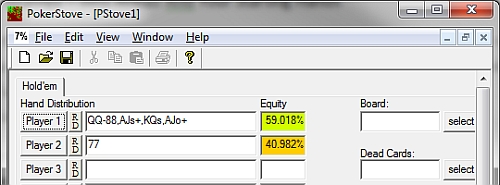Leave Behind Your 'Fixed' Starting Hand Selections –
By Adjusting To These Pre-Flop Poker Tournament Situations
After a reasonably successful weekend at the poker tournament tables I noticed a mistake coming up again and again from my less experienced opponents. Thinking through what was happening I came to the conclusion that many players were mixing up the idea 'playable hands' by failing to take into account pre-flop tournament situations which make their hands, well, unplayable!
This article is aimed at beginning tournament players. It will show you why your starting hand selections need to adjust depending on the betting of your opponents and stack sizes in play. In this article I will focus on those times you need to tighten up – there are plenty of articles in the main poker tournaments section here at SNG Planet which cover good times for making moves.
I start with multi-way pots and times you see a raise and re-raise ahead. Then cover situations where the betting is 'open' or 'closed' and how this affects starting hands. Finally stack sizes, and how many times the big blind you or your opponents currently have are factored in.
Pre-Flop Poker Tournament Strategy – Betting Ahead And Your Starting Hands
Here is a real example from this weekend from the always-fishy (easy!) ACR Poker. There was a raise from early position, a mid-position player bet all-in and a 3rd player called… the original raiser then also called and we had a 3-way all-in before the flop. I forget the exact stacks, they were shallow though not yet critically small… maybe 20x the big blind.
The 'overcaller' (3rd player in line) in this hand had a pair of 7's. Under many circumstances a playable hand in a tournament – here is why he made a mistake in this situation.
Against the original raiser, his pair of 7's was not in bad shape. Even if we give an early position raiser a reasonably conservative range of 55+ A10o+ and KQo+ those 7's, combined with having position after the flop, would be playable.
Once the all-in comes from the 2nd player, we have to think about the kind of hands which he might do this with after he considers that the first raiser has a fairly narrow range. We also need to consider that he might be making a move.
To start with we look at the legitimate hands:
Aces and Kings probably raise a little less here – holders of these hands do not like to chase away action! Ace-King, Ace-Queen, Queens, Jacks and Tens all fit the bill, and depending on the tendency of the player sometimes Nines, possibly Eights, Ace-Jack Suited or King-Queen Suited too. I will grab Pokerstove and run some calculations of Sevens against this kind of range.

As you can see, the Sevens have 40% equity at best – and we have not yet even accounted for the hand which the original raise might call with.
Having seen an all-in an a call of that all-in we have to assume that a rational player will be pretty tight here. He can not think that hands in the bottom part of his range (like 88 / A-10) are good any more… In my experience players will lay down even 10's here – so we will give him JJ+, AKo+ as an overcalling range.
If the call comes then here is what happens to the equity of the 7's!

Basically, they are crushed… If the overcall by the original raiser comes half the time then we can work out the overall equity like this:
- 50% of the time we have 40% equity (at best!) and will double-up if we win.
- 50% of the time we have 25% equity (at best!) and will triple-up if we win.
Finally for this section, a sobering thought… the ‘all-in’ 2nd player might have been ‘bluffing’ – yet even if he was there is a very strong possibility that he is doing this with 2 overcards to our sevens… and some players will actually push their aces here too – trying to look weak.
The take away is this: ‘Playability’ of your hand is not based on some inherent strength, it is based on how that hand does against the types of hands your opponents might play in different situations… You do not need to be scientific about it (yet!), what you need to do is think about spots in the game where an opponent has a better than average hand and adjust your own strength requirements based on this.
Pre-Flop Poker Tournament Strategy – Open And Closed Betting
Here is second pre-flop mistake I regularly see at the tables, this time when stacks are a little 'deeper' in terms of number of big blinds. The typical scenario is this: One player raises a small amount, a second player re-raises and a 3rd or 4th or 5th player flat-calls the re-raise… next the original raiser puts in another re-raise (often a big one)… forcing those players who cold-called into a tough decision!
If we think about the kind of hands players would cold-call the original re-raise with then we can see that putting in the 4th raise by the original raiser makes a lot of sense. Small pairs, suited aces, weak ace high hands with medium 'kickers', 2 picture card hands and so on are exactly the hands which will flat the re-raise… A pair of aces or kings might be slowplaying, however these hands fare best when all-in pre-flop against a single opponent – so they are far more likely to be betting again.
Key to this mistake is that the betting is open, if the flat calls had been from just one raise then the players would have known that only the blinds had to act… a much safer situation in which to call with those mid-strength hands. When the re-raise came in there were two big problems with making such a call:
- The re-raise indicated strength, meaning those mid-strength hands were in far worse shape than if they were against a single raiser.
- The betting was open, the original raise had already shown some strength by raising in early position… there was a real danger that a re-raise would make those cold-caller fold.
Your take away: When you are considering calling a bet pre-flop with a mid-strength hand, assess whether the betting is open or closed. Be more inclined to fold easily dominated hands like ace-x when the betting is open – small pairs are often playable as long as you have deep enough stacks to be paid off with a very big pot those times you hit a hidden set of trips.
Pre-Flop Poker Tournament Strategy – Stack Sizes And Starting Hand Selections
Raises and Re-Raises ahead, open or closed betting – and now a 3rd factor which has a big influence on your starting hand selection pre-flop – stack sizes!
As we go through the tournament stack sizes relative to the blinds shift dramatically. Starting off with 100+ big blinds, you will often find yourself in situations where either you or any opponent have 10 or 15 blind stacks (or sometime less!). Making for big adjustments in how you play. I have covered general poker tournament strategy for different stack sizes in a dedicated article here – for this 'Basics' article I will list the different ways your starting hand selection is affected.
All-In Or Fold: At the 12 Big blinds mark you are no longer able to play post flop, your initial bet and then continuation bet would make you 'mathematically' compelled to call a re-raise – since you would be getting huge pot-odds on the last call. At this point you should usually go all-in or fold… forget raising pre-flop!
Effective Stack Sizes Matter: If you have 100 times the blinds and your only opponent only has 10 times the blind then you need to play a '10 times the blind strategy'… since this is all you can win or lose the 'effective' stack in play is the smaller one – make sure you adjust your starting hands accordingly.
Resteal Stacks: At around 15 times the big blind you will find yourself in a situation where a raise pre-flop which you end up folding would put you in the 12 times the blind danger-zone. Stacks between 15 and 20 times the big blind can be used as weapons! Instead of raising with them, use them for all-in re-raises, especially against opponents who raise a lot before the flop. You will find this is an effective (if risky!) way of gaining chips.
Implied Odds: When you play small pairs, suited aces or suited connectors then you are trying to hit a monster hand on the flop and win a big pot – since these hands will not win often enough unimproved to justify playing them. Be careful that you opponents have enough chips to pay you off + a few more for insurance against those times you lose even when you do hit. This is 12 times your bet for pairs and up to 20 times for suited aces and suited connectors.
Stack size awareness is a vital component of tournament strategy once you master the basics… Your take-away is this: Be aware of not only your own stack, but those of your opponents – ask yourself how their stack size is influencing their decisions… your game will improve very quickly!
Pre-Flop Poker Tournament Strategy – Choosing The Right Games For Bigger Profits!
Planet Mark’s Rec: America’s Cardroom are crushing it for online poker tournament events that welcome both US and worldwide players. ‘The Venom’ tops the list, add to this the popular OSS events, PKO games and a packed regular schedule with guarantees that are growing all the time. You'll find plenty of soft SNG action there too.
Best of all, you can get your bankroll off to a flying start with a huge 100% welcome deal using referral code: SNGPLANET.
Check out the latest promos and tournament events for yourself now at www.americascardroom.eu!
Popular Pages this Month:


